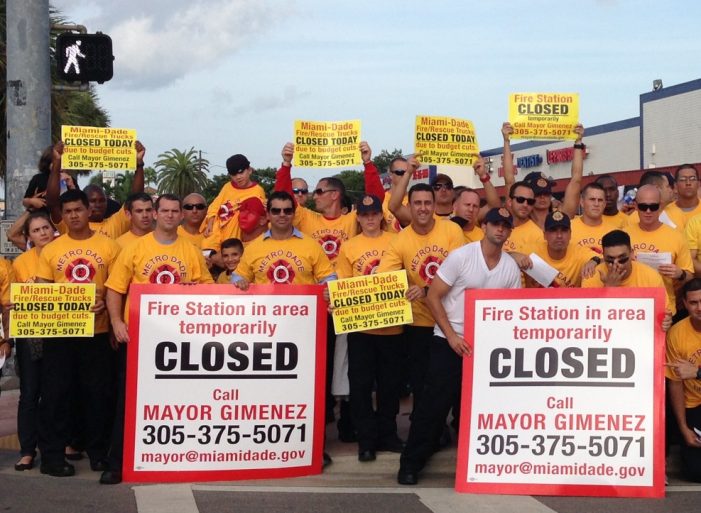The residents of Miami Lakes had no local fire rescue service Monday.
The single unit station w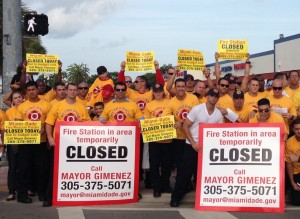 as out of service due to the rolling “brownouts” of fire trucks and rescue units — blamed on a $15 million shortfall that might or might not be real (more on that later) — and residents who called 911 had to wait longer for fire trucks or paramedics miles away.
as out of service due to the rolling “brownouts” of fire trucks and rescue units — blamed on a $15 million shortfall that might or might not be real (more on that later) — and residents who called 911 had to wait longer for fire trucks or paramedics miles away.
Same for people in Westchester, when Station 47 was taken out of service. Thursday, the rolling “brownouts” struck West Miami, and Country Walk. Today, it is the good people of Aventura and Palmetto Bay that better hope they don’t have too many real emergencies or accidents.
Even single unit stations, like the the one on 120th Street near the Turnpike, are being shut down, which means residents near there have to count on service from one of the two nearest stations — on Sunset and 117th Avenue or Kendall and 127th, which is another single unit station so they could only respond if they weren’t busy on another call.
Our average fire rescue response time is already at about eight minutes — well above the six-minute national standard that is what experts tell us is as long as a brain can survive without oxygen.
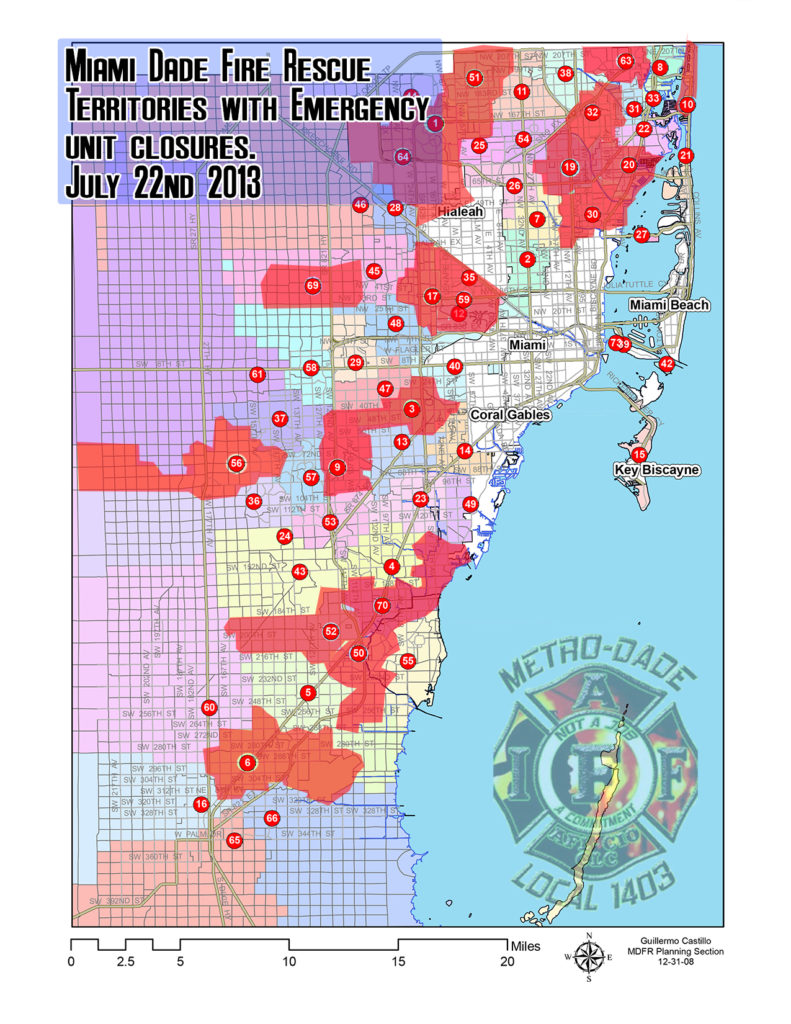 If the proposed cuts on the fire department go through, as recommended by our Miami-Dade Mayor Carlos Gimenez in his surprise, surprise about-face budget plan that suggested a flat tax rate, these “rolling brownouts” will just become standard operating procedure and we can expect those response times to go up, experts say.
If the proposed cuts on the fire department go through, as recommended by our Miami-Dade Mayor Carlos Gimenez in his surprise, surprise about-face budget plan that suggested a flat tax rate, these “rolling brownouts” will just become standard operating procedure and we can expect those response times to go up, experts say.
Because it cuts the positions of 149 personnel, including 144 firefighter positions and five civilian staffers.
And it is all happening so fast that people don’t really know what is going on. They’re still talking about cats and dogs. Ladra, like any good watchdog, is an animal lover. I voted in favor of the animal services improvement that would lead to us having a no-kill shelter. But firefighters trump cats and dogs every day of the week.
“They’re not allowing people to know the full ramifications of cutting the fire service,” said Rowan Taylor, president of the Fire Union, who adds that firefighters have given concessions since 2009 that reduced their operating costs by almost $30 million. The mayor doesn’t tell us that, of course.
“Time is so important in emergency service. And when you take a unit out of service, it takes longer to have another truck come from another area.”
One good example was the bicyclist killed in Key Biscayne a few years ago. The closest rescue unit was out of service and it took 14 minutes for a unit to arrive from South Miami.
“No one knows what the outcome would have been if we had a unit closer, but you have got to give people a fighting chance,” Taylor said, adding that the mayor had told him in March that he would raise the tax to fully fund them at current levels.
We’ll talk about that lost trust in a near future post. And we’ll talk about the irresponsible vote on setting the maximum millage rate and the looming closure of libraries later. Because these two things, as well as the voter-mandated animal services improvements — are all three separate matters and the county commission was foolish (read: conniving) to take it all in one bite. Commissioner Jose “Pepe” Diaz‘s attempt to divide them and take them on separately was shot down.
And we’ll also get back later to the sneaky way that commissioners, under the mayor’s lead, cancelled the meeting next Tuesday, which would have been the only chance for residents and firefighters to make their case and for them to rethink their boneheaded decision to go with the lowest possible millage, which gives them no wiggle room to debate, even if they came back to a flat tax rate later.
But let’s talk about the first responders first. Firefighter paramedics are and should remain a priority. Even if we have to lose some libraries and, heaven forbid, some of our four-legged friends, this is one area where cuts should not be made as a package deal.
They are our lifeline. We are talking real life and death issues here. And Ladra is really sick and tired of the whining done by some politicians and others about firefighters.
I’ve heard politicians complain of their “bloated salaries” . But for some reason, they don’t see the seaport director’s salary — which was raised almost 70 percent recently from $170,000 a year to $290,000 — as a bit bloated. None of them complain about the mayor’s large and well-paid staff and the other raises he has given to his chosen few (more on that later).
I’ve heard a state representative say that firefighters have cushy jobs. Say what? Just because they work 24-hour shifts and then get two days off to recover? You try working 24 hours straight in a busy urban zone where you answer an average of 18 or 20 medical and accident calls. You try getting puked on by some drunk and/or drug addict whose life you are trying to save. You try running into a burning house — over and over again — to pull out children that are really already dead, melting in your arms, while your laddermate resuscitates the mother who lit the house on fire.
You try living with that as well as the life-threatening conditions that make firefighters’ life expectancy one of if not the shortest in public servants.
Why would anyone want to do that for a living?
The county’s excuse for the rolling “brownouts” in our community is that our firefighters exceeded the overtime limits they had agreed to in the last contract. But they don’t go to work on OT because they just come in cuando les da la gana. They don’t come in because they just felt like it. They get OT when they are called upon to. When they are called in by their supervisors to cover for an empty shift. And that is because there are gaping holes in the force. Which could be (read: is) the county administration’s fault.
“We’ve gone five years with no new hirings. That’s why the overtime is so high. We are covering for a shortage of personnel,” said Lt. Bridgete Keating, a 25-year veteran.
There are more than 100 current vacant positions. And while there have been new hires to replace retiring staffers, it’s not making a dent in that. The class of 40 recruits this year, for example, will basically take the place of about 40 firefighters who are leaving for retirement or greener pastures.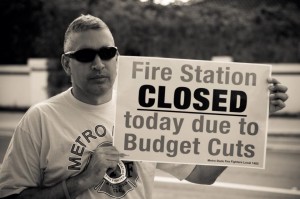
But there has been no increase in the number of positions and the department is still operating with staffing levels from 2008 — despite a 10 percent increase in the number of 911 calls. That amounts to about 3,000 more calls a year.
They are already doing more with less. On a recent week they had nine units out of service due to a lack of manpower. But now, they make up for it by stretching with what they have. Like the 16 units that responded to a building fire Wednesday on Bird Road and 127th Avenue.
Last year, the mayor cut the only fire boat from service. That was a bad move and the boat should be reinstated. Instead, now Gimenez is cutting six to eight units and basically firing dozens of firefighters paramedics. Sure, some will just move or transfer to other jobs. But not the majority.
And the first ones out will be the last ones in (read: the lowest paid members of the force). People like Ralph Sam, 31, a recruit hired on June 10 who could be on the unemployment line in weeks. His wife, who has been a firefighter for six years, could be cut, too. “That would mean the whole household is unemployed. And we have a small child,” said Sam, who — like 20 of the 40 recruits in the newest class — are veterans who left other departments to come here.
“Now I don’t know where I’m going to go,” he told Ladra.
Yes, the cuts could go that deep. Mauro Santos, 39, of Miami Lakes was hired in 2008 and never had a minute of job security, even though he answers an average of 18 or so medical and accident calls a day working at a Kendall station.
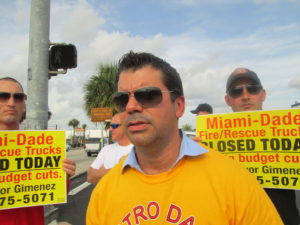
“I’ve been getting fired for five years,” Santos said, as he and about 100 others in bright yellow shirts stood on the corner of Southwest 8th Street and 62nd Avenue to protest the cuts and seek the public’s support.
Some told me they had picked that spot because it’s smack dab in the middle of Commission Chairwoman Rebeca Sosa‘s district — and she is being called out for her lack of leadership on this issue. But there were also protests planned in Miami Lakes and Palmetto Bay. They are “rolling protests,” rolling with the brownouts.
Sosa was one of the seven commissioners — and likely led the charge — who signed off on cancelling Tuesday’s meeting. The others are Commissioners Esteban Bovo (whose district covers Miami Lakes) and Lynda Bell (whose area includes Palmetto Bay), as well as Bruno Barreiro, Javier Souto (whose district includes Westchester, where there will be a rally from 7 to 9 a.m. Monday in front of station 47 on Coral Way and 94th Avenue), Xavier Suarez and Juan C. Zapata.
Chip Iglesias, the mayor’s chief of staff and, like Gimenez, a firefighter once upon a time, said the brownouts were in the union contract and would help with a $15 million budget shortfall in the department. He told reporters that residents would not feel it. That it would be like someone calling in sick, although they would likely call someone in on OT, or a truck broke down.
But that’s now. What happens when we are working with 140 fewer firefighters. Will we still not feel it?
Of course we will. And that is why the mayor originally proposed a tax increase for fire service.
“The decision to close fire units and libraries is an especially difficult one,” Mayor Gimenez wrote in a piece published by the Miami Herald last weekend. “I will continue to work throughout the summer to lessen the service impacts to our residents and to reduce the number of layoffs. But I firmly believe that adversity can also bring opportunity. I see an opportunity to streamline and improve our fire-rescue services, and bring more innovation and technology to our libraries.”
That’s just fine and dandy. But we still need the manpower.
And he knows that. That is why he had originally proposed a tax hike that “I believed at the time were reasonable increases to the fire and library millages to maintain current levels of service. These proposals did not fund salary increases or new government programs — they simply allowed us to maintain current service levels,” Gimenez explained.
“Despite these modest proposed increases, it quickly became clear to me that there is simply no support in our community for any tax rate increase at this time. The difficult reality is that many of our families and neighbors are still struggling. Our economy isn’t out of the woods yet,” he said, practically tripping over the excuses.
But he had also proposed a “small increase to the countywide millage rate that would have provided for the full implementation of the no-kill plan.”
Maybe people were upset about that. Because, frankly, if you put out a referendum today that asks people if they would agree to a small additional tax in order to keep their 911 response times shorter, I bet it would be approved by a far wider margin than the one to make our shelter a kill-free zone.
“My job as mayor is to listen to the people,” said the same mayor who was pushing for a Dolphin stadium tax that nobody supported. And he doesn’t seem to be listening to the hundreds of people signing a petition to save our libraries.
Gimenez said he would continue the conversation with town hall meetings in the coming weeks.
I hope it’s not too late to fix his priorities. If it is, then this is just political doubletalk.

